This article is a revised translation of ”Pegasus og den dystende ridder” by E. Stautz, V. Birkelund and C. Munkholt, published in Kikkenborgen, 2020. It tells the story of a unique collection of historical photos from the allied liberation of Denmark in the summer 1945.
When this photo below of five British soldiers was published in the local Dragør newspaper in connection with the 75th anniversary of the liberation of Denmark in May 1945, the Local History Archive was contacted by a reader.
He remembered how as an 8-year-old schoolboy, he and his friends would write down number plates in a little notebook. The most exciting ones were those on the British military vehicles that were parked next to a workshop in Kirkevej in the neighbouring village of Store Magleby in the summer of 1945. He wondered why the jeep in the photo had no number plates. The answer to this was to come from an unexpected quarter.
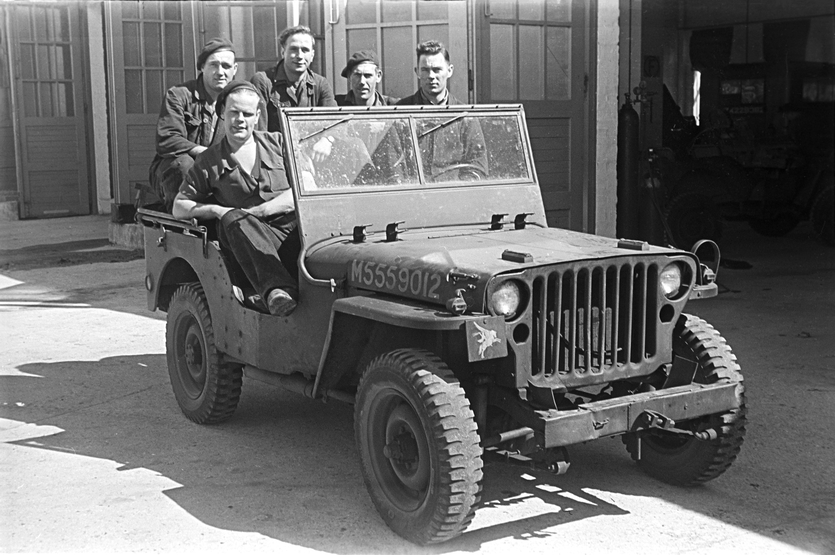
In the Local History Archive we have very few photos of the German occupation forces in Dragør and Store Magleby until May 1945. While it wasn’t strictly forbidden, one had to be very careful taking photos during the years of the German occupation of Denmark from 1940-1945.
Immediately after the German capitulation, however, photography took off, and the days of the liberation in May 1945 were well documented. So ever after 75 years, we can see how joyful people were at being liberated.
In Store Magleby village, Poul Villiam Petersen was given the task of being the official photographer for the A3 Company, the Danish underground military unit that his sub-unit from Store Magleby village was part of.
His unit emerged ready for mopping up operations, as soon as the Germans had capitulated. The proximity to Copenhagen Airport and Dragør Fort meant that they were soon guarding German planes and taking charge of weaponry and ammunition from the German and Hungarian soldiers taken prisoner.
In the village school in Store Magleby, one of its teachers, Hans Hauge, who was a keen photographer had made a darkroom. Here (the over 300) photos that Poul Petersen took, as well as the (ca. 100) photos that Hauge took during the days of liberation were developed by them.
Shortly after the German capitulation, British troops landed in the nearby Kastrup (Copenhagen) Airport. And in the following days, other allied troops also arrived in Denmark. Their vehicles were parked near the airport, and soon needed repairs at a workshop in Store Magleby. Here, the German hangars and workshop for repairing their warplanes, were now taken over by British troops.
In the heady days of the liberation, British troops were treated as heros, and the two amateur photographers from Store Magleby village took many photos of them. Later on, their entire collection of photos from these days was handed over to the Local History Archive in Dragør. In recent years the photos were digitalized and made available to the public through Arkiv.dk, the portal belonging to the Association of Local History Archives in Denmark (see also links below).
In order to find out more about the photos, the archive contacted museums in the UK, which provided us with much new information on the British troops who fought their way through German-occupied Europe. The emblems on their uniforms and vehicles tell us to which divisions and brigades the troops in Store Magleby belonged.
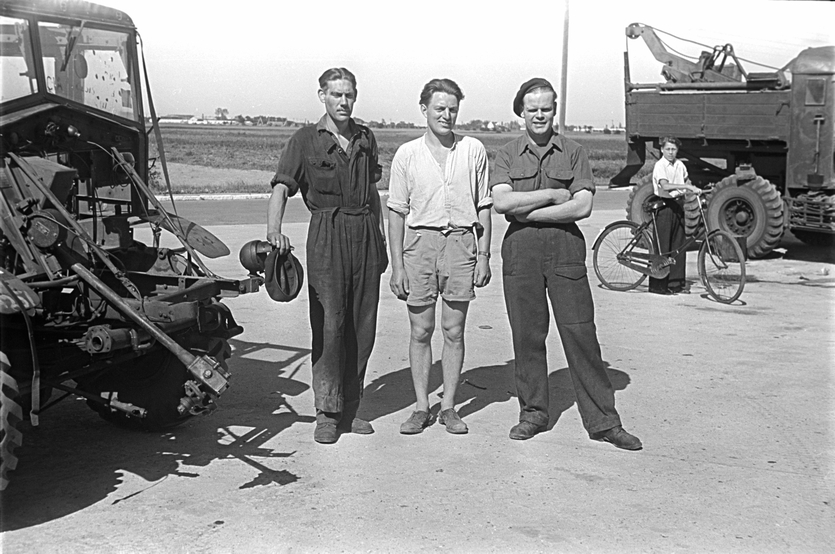
It all began back in 2018, when some of the volunteers at the archive began to work with the huge number of photos from the liberation days taken by Poul Petersen and Hans Hauge.
The few that were already developed even included information on the people in the photographs, but most had remained undeveloped. Of these, there were some 60 or so photos of British soldiers that made us curious.
The photos were sharp and the men were clearly happy to have their photos taken, and we wondered who they were, and if their families back in the UK would be interested in the photos.
We first wrote to the RAF Museum in England, as we assumed that most of the photos taken at the workshop in Kirkevej 24, Store Magleby, must have been of RAF mechanics. The RAF Museum replied that the men were not from the RAF. However, they could identify one of the men as an officer of the Royal Electrical and Mechanical Engineers (REME), and one of the vehicles as a Scammel Pioneer associated with REME.
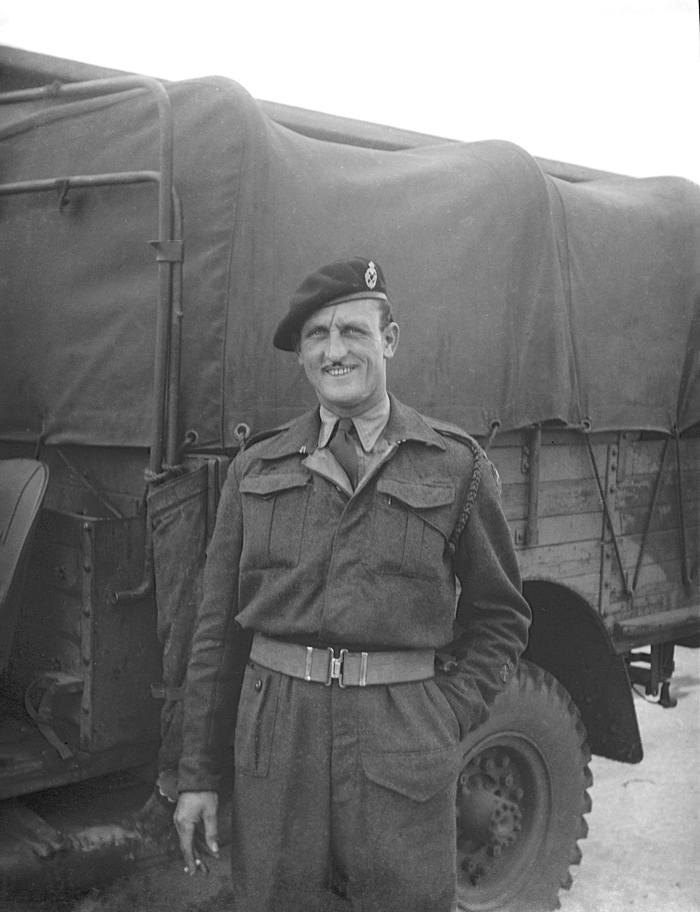
REME still exists with its own museum. When we contacted the REME Museum, they replied with interest, as REME’s history in Scandinavia in general and Denmark in particular was not so well known to them.
The REME Museum’s archivist offered to investigate in their own archives, but also recommended us to find out which British units had been in the vicinity of Copenhagen Airport in the days of the liberation. Here we encountered a problem, as the two main museums we contacted here did not have the information we needed.
However, we found some information on REME on the internet. In August 1940, when the war was going badly for Great Britain, a committee under the liberal economist William Beveridge (author of the famous Beveridge Report that lay the foundation for the welfare state) was given the task by the War Office to find out how craftsmen and other civilians could be used more optimally in the military throughout the British Empire.
One of his recommendations, in his second report from October 1941, was to rationalize and place all rescue efforts and repairs of military vehicles and equipment throughout the armed forces under one unit. This meant that many units that had done similar tasks were placed together, and REME was established in May 1942 and made operational in October 1942[1].
Small groups of trained REME men, called Light Aid Detachments (LADs) were attached to other military units and sent around the world. Some of them were, for example involved in the second battle of El-Alamein where over 1000 tanks were rescued with the help of Scammel Pioneer lorries and repaired. [2]
Thus, they not only were to be found in military workshops, but also on the battlefields in Normandy and Arnhem for example, and like their fighting colleagues killed or injured in battle. This means that the men in our archive photos may have experienced war at close hand before they arrived in the more peaceful village of Store Magleby.
Behind the smiling faces on the photos from Store Magleby in the summer of 1945, are perhaps hidden the history of men who had been at war for six years, far away from their homes and loved ones.
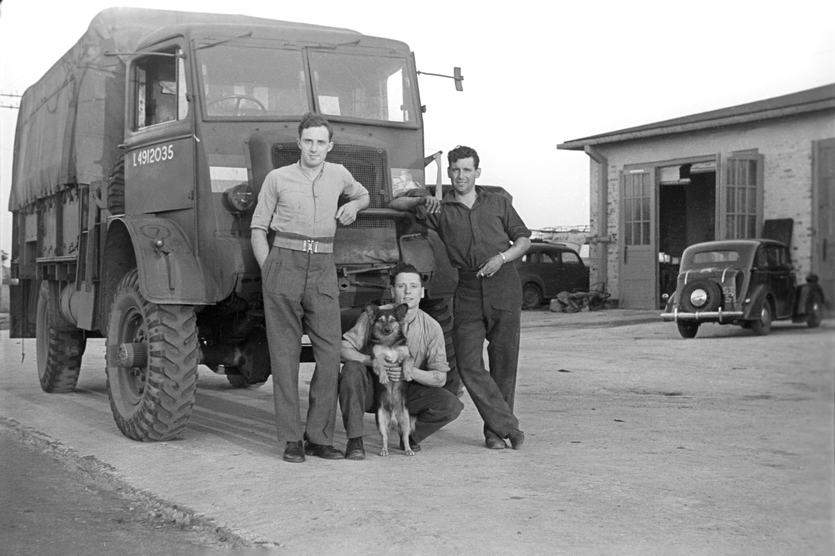
The archivist at our Local History Archive then took the decision to share all the photos we had from the workshop in Store Magleby with colleagues from the REME Museum in England. Here, thanks to a diligent archive assistant who researched the matter thoroughly, we received a great deal of useful information.
Among the British troops who accompanied Major General Richard Dewing from the Supreme Headquarters of the Allied Expeditionary Forces (SHAEF) on the 5th May 1945 to Copenhagen, was an escort from B Company of 13th Airborne Battalion.
Shortly thereafter also a unit of the 1st Parachute Brigade, and men from the 1st Royal Dragoons and 2nd Battalion King’s Royal Rifle Corps (Motor Battalion) came to Denmark. From our photos, the archive assistant from the REME Museum was able to identify men who belonged to at least two groups.
One group of men had the Pegasus emblem that belonged to the British Airborne troops on their uniforms and vehicles. A couple of the REME men from this group also wore a logo with a parachute, indicating they were qualified to jump. She believed that they could have belonged to the NO.1 LAD attached to the 1st Parachute Brigade.
The other group of men had the emblem of the jousting knight that belonged to the VIII Corps on their vehicles and uniforms. Thus, this LAD would have been with the Royal Dragoons, who were in the 7th Armoured brigade of the 8th Corps that from March to May 1945 fought its way up through Germany.
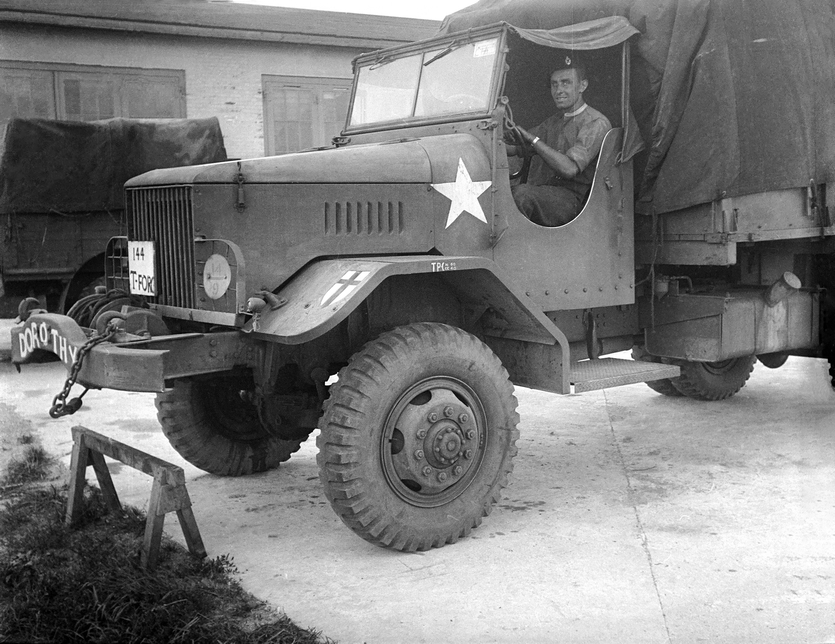
The images of the British jeeps in the archive’s photo collection remind us that the jeeps were originally produced in the USA and sent to the UK (and other allied nations) under the Lend-Lease programme.
According to the REME Museum, the star that can be seen on some of the vehicles was called the “Allied star”. The white 5-pointed star was painted on some of the allied vehicles so that their vehicles could avoid attracting friendly fire. According to REME Museum, in certain cases, a circle was painted around the star, so that British bombers could clearly distinguish Allied vehicles from German ones at a long distance. Some allied units refused to use them, as they were too visible to German bombers. Canadian troops had the star painted at an angle to distinguish their vehicles from the US version.
At the time of writing, the REME Museum was in the process of trying to find more information on REME’s presence in Denmark by using the series of photos of REME personnel from our Local History Archive. They also made an enquiry via their blog, https://www.rememuseum.org.uk/blog/reme-history-reme-in-denmark
Moreover, they recommended that we contact the archives of the Royal Logistic Corps when it reopens, as several of our archive photos contained British Army vehicles with clearly identifiable number plates, and the Royal Logistic Corps contains records of wherever in the world these vehicles have been.
The REME Museum also identified the Combined Operations logo in another photo in our archive. The photograph had been taken on the 7th of May 1945 of the first British soldiers to come to Store Magleby School, the temporary headquarters of the Danish underground military Company A3. Our archive then contacted the National Army Museum in the UK, which identified the man as a leading airman in the RAF accompanied by a corporal and private from the army.
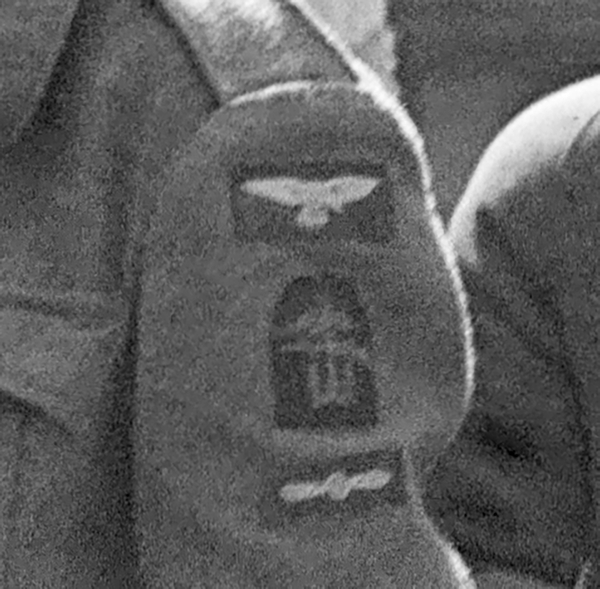
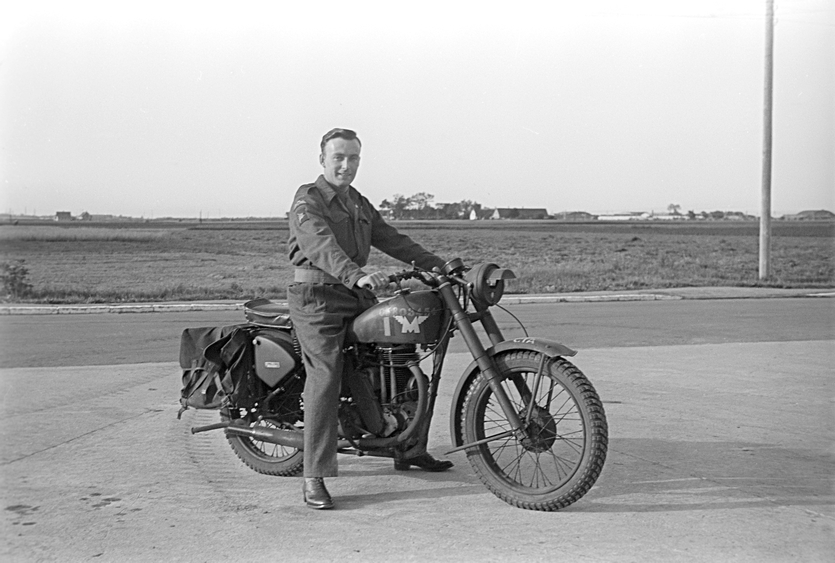
From other photos we sent him, the curator at the National Army Museum also identified soldiers of the Parachute Regiment at Dragør Fort.
Moreover, he informed us that the soldier in a jeep in front of the Royal Theatre in Copenhagen in a photo taken by Poul Petersen appeared to wear the special coverall jacket called a Denison Smock usually worn by Airborne troops. He recommended we try the Airborne Assault Museum for more information.
Here the Assistant curator/ParaData manager confirmed that the British troops in the photos taken at Dragør Fort on the 11th may 1945 belonged to the Airborne troops.
This was interesting, as our archive contains a lengthy newspaper interview (Politiken, 30th August 1981) with James Knox Russell, (a professor of obstetrics and gynaecology) who as a young doctor was in RAF Bomber Command.
He was stationed in Denmark from the liberation to the spring of 1946, and lived at the Strand Hotel in Dragør during this period. He recounts how he flew to Copenhagen during the liberation with, among others, soldiers from a Lancashire battalion.
According to the Assistant curator at the Airborne Assault Museum, the 6th Airborne Division that landed in Copenhagen on the 5th May 1945 included the 1st Para Brigade as well as the (South Lancs) 13th Parachute Battalion.
He also mentioned in passing that he could see that the jeeps in our photos may have had airborne modifications, to make them less heavy and more easily transportable along with the Airborne troops in aircraft and gliders such as the Airspeed Horsa. [4] So here was the answer to our reader’s question, as to why the vehicle in the photo did not have a number plate in front.
Sources
The information in the text was provided by the following museums to whom we are grateful:
RAF: https://www.rafmuseum.org.uk/;
REME: https://www.rememuseum.org.uk/2020/05/19/reme-in-denmark/; National Army Museum: https://www.nam.ac.uk/
Airborne Assault Museum, IWM: https://www.paradata.org.uk/
Dragør Local History Archive’s REME photo collection may be seen on: https://arkiv.dk/en/vis/5515023 under “More content”, and below that are links to other photos of British soldiers and airmen in Dragør and Store Magleby. See also: https://arkiv.dk/en/vis/5693117 and https://arkiv.dk/en/vis/5696817
[1] https://en.wikipedia.org/wiki/William_Beveridge and //filestore.nationalarchives.gov.uk/pdfs/small/cab-66-21-wp-42-44-24.pdf
[2] https://www.army.mod.uk/who-we-are/corps-regiments-and-units/corps-of-royal-electrical-and-mechanical-engineers-reme/
[3] For more see: https://www.iwm.org.uk/collections/item/object/1060020965
[4] https://www.paradata.org.uk/article/airborne-jeep and https://www.dehavillandmuseum.co.uk/aircraft/airspeed-as-51-58-horsa-glider/